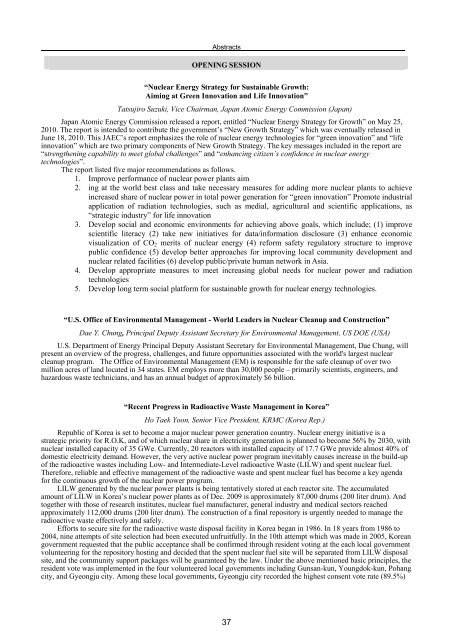The 13th International Conference on Environmental ... - Events
The 13th International Conference on Environmental ... - Events
The 13th International Conference on Environmental ... - Events
You also want an ePaper? Increase the reach of your titles
YUMPU automatically turns print PDFs into web optimized ePapers that Google loves.
Abstracts<br />
OPENING SESSION<br />
“Nuclear Energy Strategy for Sustainable Growth:<br />
Aiming at Green Innovati<strong>on</strong> and Life Innovati<strong>on</strong>”<br />
Tatsujiro Suzuki, Vice Chairman, Japan Atomic Energy Commissi<strong>on</strong> (Japan)<br />
Japan Atomic Energy Commissi<strong>on</strong> released a report, entitled “Nuclear Energy Strategy for Growth” <strong>on</strong> May 25,<br />
2010. <str<strong>on</strong>g>The</str<strong>on</strong>g> report is intended to c<strong>on</strong>tribute the government’s “New Growth Strategy” which was eventually released in<br />
June 18, 2010. This JAEC’s report emphasizes the role of nuclear energy technologies for “green innovati<strong>on</strong>” and “life<br />
innovati<strong>on</strong>” which are two primary comp<strong>on</strong>ents of New Growth Strategy. <str<strong>on</strong>g>The</str<strong>on</strong>g> key messages included in the report are<br />
“strengthening capability to meet global challenges” and “enhancing citizen’s c<strong>on</strong>fidence in nuclear energy<br />
technologies”.<br />
<str<strong>on</strong>g>The</str<strong>on</strong>g> report listed five major recommendati<strong>on</strong>s as follows.<br />
1. Improve performance of nuclear power plants aim<br />
2. ing at the world best class and take necessary measures for adding more nuclear plants to achieve<br />
increased share of nuclear power in total power generati<strong>on</strong> for “green innovati<strong>on</strong>” Promote industrial<br />
applicati<strong>on</strong> of radiati<strong>on</strong> technologies, such as medial, agricultural and scientific applicati<strong>on</strong>s, as<br />
“strategic industry” for life innovati<strong>on</strong><br />
3. Develop social and ec<strong>on</strong>omic envir<strong>on</strong>ments for achieving above goals, which include; (1) improve<br />
scientific literacy (2) take new initiatives for data/informati<strong>on</strong> disclosure (3) enhance ec<strong>on</strong>omic<br />
visualizati<strong>on</strong> of CO2 merits of nuclear energy (4) reform safety regulatory structure to improve<br />
public c<strong>on</strong>fidence (5) develop better approaches for improving local community development and<br />
nuclear related facilities (6) develop public/private human network in Asia.<br />
4. Develop appropriate measures to meet increasing global needs for nuclear power and radiati<strong>on</strong><br />
technologies<br />
5. Develop l<strong>on</strong>g term social platform for sustainable growth for nuclear energy technologies.<br />
“U.S. Office of Envir<strong>on</strong>mental Management - World Leaders in Nuclear Cleanup and C<strong>on</strong>structi<strong>on</strong>”<br />
Dae Y. Chung, Principal Deputy Assistant Secretary for Envir<strong>on</strong>mental Management, US DOE (USA)<br />
U.S. Department of Energy Principal Deputy Assistant Secretary for Envir<strong>on</strong>mental Management, Dae Chung, will<br />
present an overview of the progress, challenges, and future opportunities associated with the world's largest nuclear<br />
cleanup program. <str<strong>on</strong>g>The</str<strong>on</strong>g> Office of Envir<strong>on</strong>mental Management (EM) is resp<strong>on</strong>sible for the safe cleanup of over two<br />
milli<strong>on</strong> acres of land located in 34 states. EM employs more than 30,000 people – primarily scientists, engineers, and<br />
hazardous waste technicians, and has an annual budget of approximately $6 billi<strong>on</strong>.<br />
“Recent Progress in Radioactive Waste Management in Korea”<br />
Ho Taek Yo<strong>on</strong>, Senior Vice President, KRMC (Korea Rep.)<br />
Republic of Korea is set to become a major nuclear power generati<strong>on</strong> country. Nuclear energy initiative is a<br />
strategic priority for R.O.K, and of which nuclear share in electricity generati<strong>on</strong> is planned to become 56% by 2030, with<br />
nuclear installed capacity of 35 GWe. Currently, 20 reactors with installed capacity of 17.7 GWe provide almost 40% of<br />
domestic electricity demand. However, the very active nuclear power program inevitably causes increase in the build-up<br />
of the radioactive wastes including Low- and Intermediate-Level radioactive Waste (LILW) and spent nuclear fuel.<br />
<str<strong>on</strong>g>The</str<strong>on</strong>g>refore, reliable and effective management of the radioactive waste and spent nuclear fuel has become a key agenda<br />
for the c<strong>on</strong>tinuous growth of the nuclear power program.<br />
LILW generated by the nuclear power plants is being tentatively stored at each reactor site. <str<strong>on</strong>g>The</str<strong>on</strong>g> accumulated<br />
amount of LILW in Korea’s nuclear power plants as of Dec. 2009 is approximately 87,000 drums (200 liter drum). And<br />
together with those of research institutes, nuclear fuel manufacturer, general industry and medical sectors reached<br />
approximately 112,000 drums (200 liter drum). <str<strong>on</strong>g>The</str<strong>on</strong>g> c<strong>on</strong>structi<strong>on</strong> of a final repository is urgently needed to manage the<br />
radioactive waste effectively and safely.<br />
Efforts to secure site for the radioactive waste disposal facility in Korea began in 1986. In 18 years from 1986 to<br />
2004, nine attempts of site selecti<strong>on</strong> had been executed unfruitfully. In the 10th attempt which was made in 2005, Korean<br />
government requested that the public acceptance shall be c<strong>on</strong>firmed through resident voting at the each local government<br />
volunteering for the repository hosting and decided that the spent nuclear fuel site will be separated from LILW disposal<br />
site, and the community support packages will be guaranteed by the law. Under the above menti<strong>on</strong>ed basic principles, the<br />
resident vote was implemented in the four volunteered local governments including Gunsan-kun, Youngdok-kun, Pohang<br />
city, and Gye<strong>on</strong>gju city. Am<strong>on</strong>g these local governments, Gye<strong>on</strong>gju city recorded the highest c<strong>on</strong>sent vote rate (89.5%)<br />
37
















